
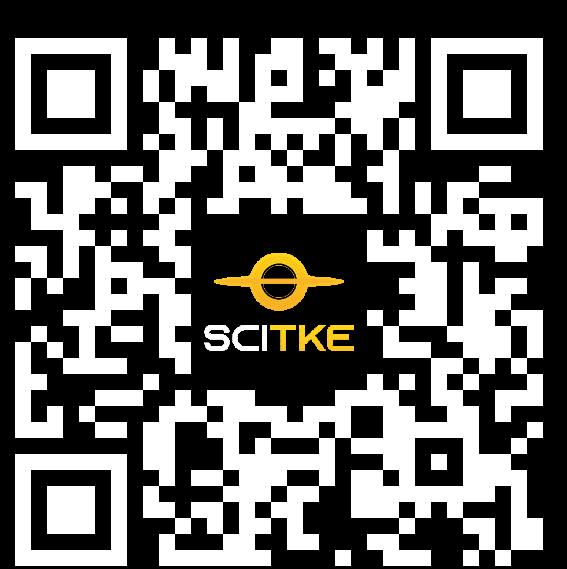


Play retro, remote play, cloud, and Android games on a lightweight handheld with great controls and a stunning 7” big screen.
Buy now





Play retro, remote play, cloud, and Android games on a lightweight handheld with great controls and a stunning 7” big screen.
Buy now

▶ Credit: US Army Corps of Engineers via New Atlas Why use an ordinary robot when you could deploy a robotic coyote? That’s the idea behind the U.S. Army Engineer Research and Development Center’s (ERDC) project—a cybernetic prairie predator designed to keep airfields free of dangerous wildlife.
Airfields constantly face the challenge of birds and other wildlife, which can seriously endanger aircraft and operations. Birds are especially hazardous—they can be sucked into engines, hit windshields, or damage control surfaces. The threat is so significant that the U.S. Civil Air Administration once developed a “chicken gun” to launch bird carcasses at aircraft to simulate real-life bird strikes.
Beyond birds, animals like rabbits and deer also pose risks by wandering


onto runways or damaging equipment through digging, nesting, foraging, or even urinating. To keep wildlife at bay, airfields have tried everything from drones and trained birds of prey to dogs, flashing lights, and gas-powered cannons.
Now, the ERDC is collaborating with wildlife biologists Dr. Stephen Hammond and Dr. Jacob Jung, along with the USDA’s National Wildlife Research Center (NWRC), to create robotic coyotes for the task.
Why use coyotes? Anyone who’s lived near a pack knows that most animals instinctively steer clear to avoid becoming prey.
After five years of development, the project produced the “Coyote Rovers,” which originally used Boston Dynamics’ Spot robots. However, these were too slow to scare off wildlife. Engineers switched to faster
four-wheeled Traxxas X-Maxx RC cars, capable of hitting 20 mph (32 km/h). They mounted plastic coyote figures on top—striking a balance between cute and intimidating—at a cost of around $3,000 each. These robo-coyotes have been tested at several military airfields, including Naval Air Station Pensacola in Florida, Fort Campbell in Tennessee, and NAS Whiting Field. While the prototypes may look like simple RC cars with coyote props, the long-term plan includes advanced features: pre-programmed routes, terrain adaptability, self-charging, multi-day autonomous operation, and even species recognition to tailor deterrence strategies. Of course, how these robot coyotes would handle robotic roadrunners remains a mystery— especially if it involves mastering catapults, giant magnets, rocket boosters, explosives, or painting convincing tunnel entrances on solid rock.
Chatbots are improving at conversation, but are they ready to provide real support in therapy?
A new study from USC researchers indicates that large language models (LLMs) like
ChatGPT still struggle to capture the subtle complexities of human connection.
That’s the takeaway from a study co-led by USC Ph.D. computer science students Mina Kian and Kaleen Shrestha, under the mentorship of renowned roboticist Professor Maja Matarić at USC’s Interaction Lab.
2025 NAACL
Finds LLMs Still Lag Behind Humans in Delivering Quality Therapeutic Support
Presented at the 2025 North American Chapter of the Association for Computational Linguistics (NAACL) conference, the research revealed that large language models (LLMs) still fall short of human standards in producing effective therapeutic responses.
The study found that LLMs underperform in linguistic “entrainment”—the ability to adapt communication based on interaction— which is crucial in building rapport between therapists and clients. Strong entrainment has been linked to better therapy outcomes.
The research also included contributions from seven additional USC computer science scholars and Katrin Fischer, a Ph.D. student at the Annenberg School for Communication and Journalism.
Large language models (LLMs) are being ex-
plored for potential use in mental health care, though they’re not yet widely adopted in clinical cognitive behavioral therapy (CBT). Some studies have also raised serious concerns, including evidence of racial and gender bias.
Twenty-six university students participated in the study, using a chat-based platform to complete either cognitive restructuring or coping strategy exer-

▶ Credit: Pixabay
“There’s a troubling narrative emerging that LLMs could replace therapists,” said Mina Kian, a USC Ph.D. student. “Therapists undergo extensive education and clinical training, so the idea that a language model could simply step in is deeply problematic.”
Kian’s research focuses on socially assistive robots (SARs) as tools to support—not replace—therapists in mental health care. In a recent study titled “Using Linguistic Entrainment to Evaluate Large Language Models for Use in Cognitive Behavioral Therapy,” her team examined how well ChatGPT 3.5-turbo handled CBT-style exercises.
Chatbot Therapy Shows Promise: Study Tracks

cises, designed to help manage stress. The researchers then analyzed transcripts for linguistic “entrainment”—how well the chatbot adapted its responses to the user’s language and emotional tone. Stronger entrainment typically correlates with greater engagement and openness in therapy sessions.
However, when compared to responses from professional therapists and peer supporters on Reddit, the LLM demonstrated consistently weaker entrainment.
“There’s growing effort in the natural language processing field to rigorously evaluate LLMs in sensitive areas,” said co-author Kaleen Shrestha. “As these technologies gain influence, we need targeted studies
like this to better understand their limitations and risks.”
While LLMs might help users navigate guided therapy exercises at home, Kian and her team stress they are no substitute for trained professionals.
“I’d like to see more research assessing LLMs in a broader range of therapy styles beyond CBT— like motivational interviewing or dialectical behavior therapy (DBT),” Kian said. She also called for evaluations based on a wider set of therapeutic outcomes.
Kian plans to continue her work exploring SAR-supported CBT exercises, particularly for people with generalized anxiety disorder. “My goal is to help expand the toolkit therapists can use for at-home care,” she added.
We’re moving closer to operating rooms where we’re the only humans present, thanks to the world’s first surgery carried out by a robot that could respond and learn in real time. Its precision and expertise were on par with that of veteran surgeons.
Researchers at Johns Hopkins University
trained a robot using surgical videos, then tasked it with independently performing a gallbladder removal—guided only by voice commands, similar to how a surgical team supports a lead surgeon. Called SRT-H (Surgical Robot Transformer-Hierarchy), the robot translated its training into practice, repeatedly and successfully removing the gallbladder while making real-time adjustments as needed.
“This development shifts us from robots that simply carry out predefined surgical tasks to those that genuinely comprehend surgical procedures,” explained medical roboticist Azwl Krieger. “It’s a crucial leap toward autonomous surgical systems that can operate effectively in the chaotic and unpredictable environment of real-world patient care.” SRT-H marks a major breakthrough in the field, showcasing not just mechanical precision but also the more complex capability to adapt and respond in real time—making adjustments as needed rather than strictly following a predetermined plan.
Robot Performs Complex Gallbladder Surgeries on Human-Like Models with Precision and Accuracy Across Multiple Procedures
While this study highlights SRT-H’s ability to perform complete gallbladder removals (cholecystectomies) across eight different procedures, it’s important to note these surgeries were conducted on highly realistic human-like models—not actual humans. Still, the synthetic tissues closely resembled human anatomy, and the robot smoothly completed the operation, which involved 17 distinct tasks, each taking only a few minutes. SRT-H accurately identified key ducts and arteries, applied clips with precision, and cleanly cut tissue with surgical scissors.
Stanford University. “It proves that AI models can be made reliable enough for autonomous surgery—something that once seemed far-off but is now within reach.”
ChatGPT-Powered Surgical Robot Learns and Adapts in Real Time, Mimicking Human Surgeons Through Experience
SRT-H is powered by the same machine learning architecture as ChatGPT, allowing it to interpret spoken instructions from nearby medical staff, learn in real time, and adapt its actions if it encounters tissue that looks or behaves differently than expect-
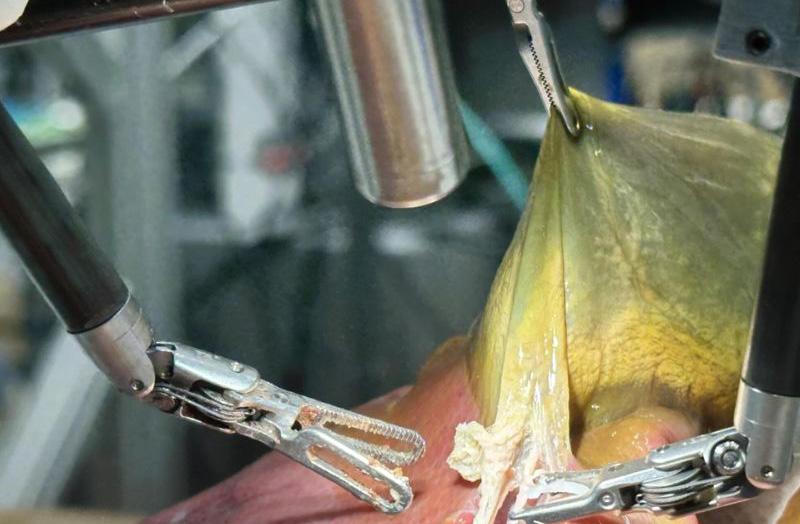
“This work marks a significant advancement over previous efforts because it addresses some of the core challenges in bringing autonomous surgical robots into real-world clinical environments,” said lead author Ji Woong “Brian” Kim, a former postdoctoral researcher at Johns Hopkins and now at

ed. Although the robot’s initial training was imitation-based, it continues to improve through experience—much like a human surgeon.
Previously, SRT-H achieved a flawless success rate when performing the same gallbladder procedure on pig organs (from cadavers or synthetic sources). The field of surgical robotics is
progressing rapidly; just a year ago, the Johns Hopkins team trained a robot to complete three core surgical skills: needle handling, tissue manipulation, and suturing—all in mere seconds.
Krieger’s 2022 STAR Robot Made History with First Autonomous Surgery on a Live Animal— Though Heavily Guided by Humans
Before that, in 2022, Krieger’s earlier project— the Smart Tissue Autonomous Robot (STAR)— performed the first fully autonomous surgery on a live animal, conducting laparoscopic surgery on a pig. However, STAR required considerable human guidance, with staff marking tissues and the robot following a predefined path.
According to Krieger, the new system is “like teaching a robot to drive any road under any condition, making smart decisions as it goes.”
Although SRT-H currently takes longer than human surgeons to complete its procedures, the quality of its outcomes matches those of experienced professionals. It’s not yet approved for use on human patients, but the researchers anticipate that this milestone could be reached within the next decade.
“Just as surgical residents master different parts of procedures at different speeds, this research shows the promise of developing
autonomous surgical robots through modular, step-by-step progress,” said study co-author and Johns Hopkins surgeon Jeff Jopling.
Next, SRT-H is set to broaden its capabilities by being trained in a wider range of surgical procedures, moving it closer to full autonomy— potentially reaching a point where it can carry out successful surgeries without supervision or external input.
“This really demonstrates that complex surgical procedures can be performed autonomously,” said Krieger. “It’s a strong proof of concept showing that an imitation learning framework can reliably automate intricate operations with remarkable precision.”
YouTube is set to update its policies to limit creators from monetizing “inauthentic” content, such as mass-produced or repetitive videos types of content increasingly generated using AI tools.
Starting July 15, the platform will update its YouTube Partner Program (YPP) monetization rules, offering clearer guidance on what content qualifies for revenue and what doesn’t.
While YouTube hasn’t published the exact
wording of the new policy, its Help page states that creators must always produce “original” and “authentic” content. The upcoming update aims to clarify what qualifies as “inauthentic” in the current content landscape.
YouTube Eases Concerns Over Monetization of Reaction and Clip-Based Content
viewers typically see it as spam.
What Ritchie doesn’t mention, however, is how much simpler it has become to produce this kind of content.
The surge in AI tools has led to a flood of

▶ Credit: Omar Marques_ SOPA Images_LightRocket_ Getty Images
Some creators feared the policy update might restrict monetization of content like reaction videos or those using clips, but YouTube’s Head of Editorial & Creator Liaison, Rene Ritchie, clarified in a post that this won’t be the case.
In a video update posted Tuesday, Ritchie described the change as a “minor update” to YouTube’s long-standing YPP policies, aimed at more clearly identifying mass-produced or repetitive content.
He also noted that such content has already been ineligible for monetization for years, since

low-quality, AI-generated material on YouTube— often referred to as “AI slop.” These include videos with AI-generated voiceovers layered over images or reused clips, made possible by text-to-video tools. Some AI music channels now boast millions of subscribers, and fake AI-generated news videos—such as those about the Diddy trial— have attracted millions of views.
Earlier this year, 404 Media reported that a viral true crime series on YouTube was entirely AI-generated. Scammers misused YouTube CEO Neal Mohan’s image in an AI-generated phishing scam on the plat-
form, even though users can report deepfakes using available tools. Although YouTube portrays the upcoming policy shift as a minor update or clarification, the growing presence of AI-generated content— and the monetization of it—poses a real threat to the platform’s credibility and overall value. It’s no surprise, then, that the company is pushing for clearer rules that would enable large-scale removal of AI slop creators from the YouTube Partner Program.
“Our research shows that dopamine signaling in the brain is far more intricate than previous-

ly believed,” said lead author Christopher Ford, a professor at the School of Medicine. “We’ve long known dopamine influences a wide range of behaviors, and this study begins to explain how it might regulate each one individually.”
▶ Credit: Depositphotos Instead of flooding the brain as once thought, dopamine is released in precise, ultra-rapid bursts that target specific neurons. This breakthrough overturns a century-old understanding of dopamine and could revolutionize treatments for conditions like ADHD and Parkinson’s disease. Researchers at the University of Colorado Anschutz Medical Campus discovered, while studying dopamine transmission, that the neurotransmitter doesn’t spread through the brain like a mist. Instead, specific triggers cause dopamine to release in localized hotspots. Rather than being gradual or continuous, the release happens in rapid, targeted bursts switching on and off and aiming at different neural targets.
By using two-photon
microscopy, the researchers observed that dopamine is released in distinct hotspots with millisecond accuracy. This indicates the brain can precisely direct dopamine to small groups of neurons, allowing it to fine-tune specific actions or choices. In contrast, the traditional view held that dopamine diffused broadly, acting as a general modulator of behavior.
Dopamine release in the striatum occurs with both spatial and temporal precision, revealing a far more intricate signaling system than previously thought. This complexity could lead to major advancements in understanding and treating disorders linked to dopamine imbalance—such as Parkinson’s disease, addiction, schizophrenia, ADHD, and depression.
One key insight from decades of neuroscience is that there’s no universal treatment for these conditions. Current medications, like stimulants for ADHD or dopamine agonists for Parkinson’s, generally aim to increase overall dopamine levels rather than target specific circuits.
The researchers found that dopamine operates on two levels: firing in rapid, pinpoint bursts to fine-tune specific neural circuits, while also

diffusing more slowly across broader brain regions. This dual mechanism allows the brain to simultaneously adjust individual activities and manage complex processes like learning and decision-making.
“We’re just beginning to uncover how dopamine dysfunction contributes to conditions like Parkinson’s disease, schizophrenia, and addiction,” said Ford. “There’s still much to learn about how these specific changes in dopamine signaling affect different neurological and psychiatric disorders. Ultimately, the hope is to use these insights to develop more effective treatments.”
A deeper understanding of dopamine’s “precision signaling” could significantly improve how we approach therapies for the many conditions in which this neurotransmitter plays a critical role.
A new study from the University of South Australia has revealed that regularly participating in in-person events can greatly enhance overall well-being.
A study conducted by tourism and event management researchers at UniSA and Flinders University found that
regularly attending events like festivals, exhibitions, sports games, farmers markets, and food gatherings can significantly boost positive emotions—such as joy, contentment, happiness, and excitement.
along with a stronger sense of immersion in experiences.
Associate Professor Sunny Son from UniSA noted that while it’s often suggested events can enhance well-being, there has been limited

research backing this claim.
Published in the International Journal of Tourism Research, the study also linked event attendance with greater engagement, where participants reported feeling so absorbed in the activity that they lost track of time.
Survey of South Australians Links Frequent In-Person Event Attendance to Higher Emotional Well-Being and Deeper Engagement
The researchers surveyed over 350 South Australians to explore how often they attended both in-person and virtual events, and how this correlated with their well-being. The findings showed a clear connection between frequent in-person event attendance and increased emotional well-being,
“Our study took a comprehensive view of the link between event participation and well-being,” she explained. “We found clear evidence that attending events can meaningfully enhance personal well-being, which supports using community events as a tool for improving overall mental and emotional health.”
“Well-being is becoming an increasingly important priority for individuals and communities, with strong ties to benefits in health, work performance, family life, and social cohesion,” the researchers noted.
Well-Being Tied to Better Health, Job Performance, and Stronger Communities, Researchers Emphasize Page. 7
“Research has shown that higher levels of well-being are associated with lower risks of illness and injury, as well as longer life expectancy. People who report greater well-being also tend to excel at work and contribute more positively to their communities. That makes well-being crucial—not just for public health, but also for building strong, socially connected, and resilient communities.”
The study also discovered that while virtual events—such as livestreamed concerts or online performances— can enhance a person’s sense of accomplishment, they don’t significantly affect other aspects of well-being in the way that in-person experiences do.
Dr. Eliza Kitchen, Senior Lecturer at Flinders University, emphasized that organizations can harness the benefits of in-person events by integrating them into staff reward programs, inviting stakeholders to attend, or offering complimentary tickets to employees.
“These approaches can lift morale, improve satisfaction, and create a more engaged and productive workforce,” she explained.
She also pointed out that educational institutions can use events to promote student well-being, especially given the high rates of mental health challeng-

es among youth.
“Events offer students valuable opportunities to connect with peers, reduce stress, and grow personally,” Kitchen added. “Similarly, local councils can use free public events to strengthen neighborhood ties and foster a deeper sense of support and community.”
“Ultimately, our research shows that events offer more than economic or tourism value—they play a vital role in improving well-being. That’s a compelling reason to support events for the benefit of both visitors and local residents alike.”
ery challenges existing views on pain processing and could revolutionize the way chronic pain is treated.
Pain consists of several key elements, with two primary ones being the sensory and affective components. The sensory aspect involves the physical characteristics of pain—its intensity, location, nature, and duration—while the affective component relates to the emotional experience, including the discomfort, distress, and the urge to relieve the pain.
New research from the Salk Institute has pinpointed a distinct brain circuit in mice that converts the physical feeling of pain into emotional distress.
Salk Researchers Find

▶ Credit: KOMMERS_Unsplash
Scientists have uncovered a brain circuit responsible for the emotional impact of pain, shedding light on why certain physical injuries lead to prolonged suffering. This discov-
Sensory Pain Pathway Also Drives Emotional Suffering, Challenging Long-Held Beliefs
“For years, the dominant belief was that the brain handles the sensory and emotional aspects of pain through separate
circuits,” said Dr. Sung Han, associate professor at Salk and lead author of the study. “However, there has been ongoing debate over whether the sensory pain pathway also plays a role in the emotional experience. Our findings offer compelling evidence that a branch of the sensory pathway is directly involved in generating the emotional impact of pain.”
The researchers mapped the path of pain signals traveling from the spinal cord to the brain in mice. They discovered that a cluster of CGRP-expressing neurons located in the parvicellular subparafascicular thalamic nucleus (SPFp)—part of the thalamus, the brain’s central hub for sensory information—received these pain signals and relayed them to emotion-related areas of the brain, such as the amygdala. CGRP, or calcitonin gene-related peptide, is a neuropeptide that plays a key role in pain transmission.
When these CGRP neurons were genetically deactivated in mice, the animals still sensed physical pain from stimuli like heat or pressure but showed no emotional reaction and didn’t avoid the painful stimuli later. In contrast, when the neurons were artificially activated, the mice responded with fear and avoidance behaviors— even in the absence of actual pain.
Drugs that block CGRP are already used to treat migraines, and this study helps explain why they’re effective—not only do they dampen pain signals, but they also reduce the emotional response that turns pain into distress. Conditions like fibromyalgia, migraines, and chronic back pain often come with emotional suffering that can be more debilitating than the physical pain itself. The research highlights CGRP neurons in the SPF as a promising target for therapies aimed at easing the emotional intensity of pain while preserving basic pain sensitivity.
“Pain processing isn’t just about nerves sensing pain—it’s also about the brain deciding how much that pain should matter,” said lead author and Salk neuroscientist Sukjae Kang. “By understanding the biology behind these two different processes, we can develop treatments for types of pain that don’t respond to standard medications.”
Because this pathway connects to emotional brain regions like the amygdala, it may also play a role in threat sensitivity and fear—key features of post-traumatic stress disorder (PTSD). Calming this circuit could help alleviate the emotional suffering tied to trauma.
The findings also open new avenues for studying how this same brain pathway might influence emotional pain from social experiences like grief, loneliness, or heartbreak.
“Our identification of the CGRP-related emotional pain circuit gives us a biological explanation for the difference between simply detecting pain and truly suffering from it,” said senior author Sung Han. “We’re eager to explore this further and work toward therapies that can help reduce emotional suffering.”
Vehicle (LTV) is a key element of the Artemis program, marking the return of crewed surface mobility to the Moon for the first time in over five decades. Built to carry two astronauts or operate remotely without a crew, the LTV will support a wide range of scientific and exploratory missions across expansive lunar regions.
“The Artemis Lunar Terrain Vehicle will carry humanity farther across the Moon than ever before, ushering in a new era of scientific discovery and exploration,” said Nicky Fox, associate administrator of NASA’s Science Mission Directorate.
“By integrating the strengths of both human and robotic exploration, the selected science instruments aboard the

NASA selected three instruments for a lunar mission engineers will mount two on a Lunar Terrain Vehicle (LTV), and they will reserve the third for a future orbital mission.
NASA’s Lunar Terrain

tile Distributions at the Lunar South Pole
One of these instruments, the Artemis Infrared Reflectance and Emission Spectrometer (AIRES), will analyze, measure, and map lunar minerals and volatile substances materials that easily vaporize, such as water, ammonia, or carbon dioxide. AIRES will gather spectral data superimposed on visible imagery, capturing both detailed targets and wide-area views to reveal how these materials are distributed across the Moon’s south polar region. The instrument is led by principal investigator Phil Christensen of Arizona State University in Tempe.
The Lunar Microwave Active-Passive Spectrometer (L-MAPS) is designed to probe beneath the Moon’s surface and identify potential ice deposits. Equipped with both a spectrometer and ground-penetrating radar, the instrument will assess temperature, density, and underground structures at depths of over 131 feet (40 meters). The L-MAPS team is led by Matthew Siegler of the University of Hawaii at Manoa.
LTV will uncover insights about the Moon that not only deepen our understanding of Earth’s closest celestial neighbor but also enhance astronaut safety and spacecraft performance on the lunar surface.”
AIRES to Unveil Vola-
Together, data from L-MAPS and AIRES will provide a comprehensive view of the Moon’s surface and subsurface composition, offering vital insights for future human exploration. These instruments will also shed light on the
Moon’s geological history and help identify its resources such as mineral content, possible ice locations, and long-term surface changes.
UCIS-Moon to Deliver Orbital Insights on Lunar Geology and Volatiles
Alongside the instruments chosen for the Lunar Terrain Vehicle, NASA has also selected the Ultra-Compact Imaging Spectrometer for the Moon (UCIS-Moon) for a future orbital mission. This instrument will offer a broader perspective to complement findings from the LTV. From its vantage point in orbit, UCIS-Moon will map the Moon’s geology and volatile compounds, as well as monitor how these volatiles are influenced by human activity. Additionally, the spectrometer will aid in pinpointing scientifically significant sites for astronaut sample collection, while its wide-field imagery will provide essential context for understanding the locations of those samples.
The UCIS-Moon scientific instruments mwill deliver the highest spatial resolution data yet on the Moon’s surface water, mineral composition, and thermophysical characteristics. Led by Abigail Fraeman from NASA’s Jet Propulsion Laboratory in Southern California, the UCISMoon team aims to provide detailed insights into the Moon’s composition.
“These three instruments together will make major strides in uncovering which minerals and volatile substances exist on and beneath the lunar surface,” said Joel Kearns, deputy associate administrator for Exploration in NASA’s Science Mission Directorate.
“With UCIS-Moon in orbit and the other instruments aboard the LTV, we’ll be able to study the lunar surface not only where astronauts land and work, but across the entire south polar region opening up exciting possibilities for long-term science and exploration.”
NASA Completes Design Reviews with LTV Vendors to Validate Rover Concepts
In preparation for selecting these instruments, NASA collaborated with all three Lunar Terrain Vehicle (LTV) vendors Intuitive Machines, Lunar Outpost, and Venturi Astrolab to complete preliminary design reviews. These reviews confirm that each company’s initial rover design meets NASA’s technical requirements, incorporates the right design choices, identifies key system interfaces, and outlines appropriate verification strategies.
NASA will assess the task order proposals submitted by the LTV vendors and expects to select a provider for the demonstration mission by the end of 2025.
As part of the Artemis program, NASA aims to tackle top-priority science objectives— particularly those best achieved by astronauts working directly on and around the Moon. By integrating robotic systems both on the lunar surface and in orbit, Artemis will drive scientific exploration, promote economic opportunities, and lay the groundwork for future crewed missions to Mars.
For the first time, scientists have identified a unique biological cause of “Monday dread” that occurs regardless of employment status and isn’t observed on other days of the week. Even more concerning, for some individuals, the stress triggered on Mondays may significantly increase their risk of heart problems.
Researchers at the University of Hong Kong (HKU) discovered that Mondays—often marking the beginning of the workweek—have a distinct effect on the body’s stress response, potentially leading to longterm health issues. This impact can be tracked through elevated cortisol levels found in hair samples.
“Monday acts as a cultural ‘stress amplifier,’” said Professor Tarani Chandola from the Department of Sociology at HKU’s Faculty of Social Sciences. “For some older adults, the shift into a new week triggers a biological chain reaction that can persist for months. This isn’t just about work—it’s about how deeply Mondays are wired into our stress biology, even after retirement.”
The study analyzed data from 3,511 adults aged 50 and above, taken from the English Longitudinal Study of Ageing (ELSA, Wave 6, 2012–2013). All participants recorded their stress levels on a Monday during the survey and provided hair samples, which were used to measure longterm exposure to stress hormones—specifically cortisol and its byproduct cortisone. Because the hair samples were approximately 2 cm long and taken from the scalp, they reflected hormone levels over the past two to three months.
The researchers also accounted for factors like age, sex, BMI, smoking habits, medications, and socioeconomic status.
Monday Anxiety Linked to Chronic Stress in Older Adults—Regardless of Employment Status

The results revealed that older adults who reported the highest anxiety on Mondays had significantly elevated levels of stress hormones in their hair, suggesting a prolonged, chronic stress state. This pattern was consistent among both employed and retired individuals, indicating that the stress effect of Mondays exists independently of work status.
Previous research has linked Mondays with a spike in severe heart attacks. While that earlier study isn’t directly connected to this one, the
elevated biological stress identified here may help explain the physiological mechanisms that contribute to increased cardiovascular risk at the start of the week.
Researchers linked Monday anxiety to disruptions in the hypothalamic–pituitary–adrenal (HPA) axis, the body’s main stress response system. Normally, cortisol rises in response to stress and then returns
to normal, but in chronic stress or conditions like PTSD, this system stays overactive, keeping cortisol levels high—raising the risk for heart disease, obesity, anxiety, and cognitive issues.
The study found that people who felt anxious specifically on Mondays had 23% more cortisol in their hair than those anxious on other days. The most affected— about 10% of participants—had both high cortisol and greater Monday anxiety, suggesting that only those under chronic physiolog-
ical stress show longterm biological effects. While prior research noted higher cortisol on weekdays, this study is the first to tie Monday-specific anxiety to long-term hormone buildup. Though more research is needed to track daily cortisol changes, the findings offer strong biological evidence that Monday anxiety is real—especially for older adults—and point to the need for targeted support for those at highest risk.


Taiwan’s National Laboratory Animal Center (NLAC) has developed an innovative “Laser-induced Thrombosis on a Chip System” to overcome the limitations of traditional animal testing for thrombosis treatments. This award-winning technology utilizes human blood and vascular cells to accurately simulate clot formation, enabling more precise drug efficacy testing for conditions like stroke and heart attack.



New research by Jiata Ugwah Ekele shows that rising CO2 and temperatures can reduce the nutritional value of crops like spinach and kale. While yields may increase, minerals and antioxidants decline, especially under heat stress.
This imbalance could lead to health issues such as obesity, diabetes, and nutrient deficiencies. The findings underscore the global importance of focusing on food quality—not just quantity— as climate conditions evolve.

As glaciers retreat due to climate change, volcanoes once suppressed by their weight may erupt more often and more explosively. Research in Chile and other icy regions shows that melting ice reduces underground pressure, allowing magma to rise.
This feedback loop—where warming melts glaciers, triggering eruptions that release more greenhouse gases—could reshape Earth’s climate and awaken volcanoes in places like Antarctica, Russia, and North America.
Georgia Tech researchers model wildfire impacts on climate, finding that fire-emitted aerosols suppress rain and affect global weather. Their models show that wildfires can increase risks elsewhere, revealing a complex feedback system.
Projects like ASCENT provide real-time data on air pollution from wildfires. These insights guide fire management, controlled burning, and public health decisions, especially as climate change intensifies fire frequency and reach.

Experts at the Exeter conference warned of tipping points like Amazon dieback, AMOC collapse, and ice sheet melt, each with devastating global effects. Coral reef loss and its social fallout are already unfolding.

While climate-driven tipping points draw urgency, many scientists stress that societal transformation—a social tipping point—is key to reversing course and protecting Earth’s systems.





Meta AI is a multilingual assistant integrated into Facebook, Instagram, WhatsApp, and Messenger, offering photo edits, object recognition, and chat support. It’s backed by Meta’s Llama 3.3 model and powers AR tools like Ray-Ban smart glasses.
Available in 21 countries, Meta AI blends quietly into daily use, and features can be muted in each app. With over 400 million monthly users and a stand-alone app, it’s on track to become the world’s most-used AI assistant.

Vibe coding lets anyone build apps with just a few prompts. Claude produces more polished visuals and guided workflows, ideal for beginners and stylish apps. Gemini adds smart tools like content generation and task automation, offering more functionality.
Both AIs are strong, but Gemini’s enhanced features often improve results with fewer prompts, making it the better all-around choice for building practical, AI-powered tools.





A USC–DeepMind study found colorblind individuals and ChatGPT understand color idioms largely through language. Painters, however, excel at interpreting novel metaphors due to sensory experience.
AI mimics patterns but lacks embodied grounding. Real understanding of metaphors may need multimodal training, blending images or touch, though privacy and safety concerns remain.
Researchers used small neural networks to uncover realistic human and animal decision-making, revealing patterns that traditional models miss. These compact AI systems predicted both optimal and suboptimal behaviors and allowed clearer interpretation of individual strategies.
Their findings suggest personalized decision models could aid mental health and cognitive science, just as genetics reshaped medicine.




Image Credits: (Oni Press_Massive Monster_Devolver Digital) via Engadget Cult of the Lamb Comic Returns with New OneShot Special
Top Blockbusters to Stream on
Peacock’s movie library includes iconic titles like Jaws, Oppenheimer, The Matrix, and Titanic. From action to drama, comedy to sci-fi, the platform offers high-quality films that have defined genres and generations.
Standouts include Forrest Gump, Jurassic Park, Erin Brockovich, Goodfellas, Friday, and The Birdcage, making it a top destination for unforgettable movie nights.
JMGO’s PicoPlay combines Full HD projection, Bluetooth audio, and ambient light in a travel-friendly form. With GTV, HDR10 support, and auto-focus, it’s easy to set up and stream in dark spaces.
Though limited to 400 lumens, it performs well in low light. Add a powerbank stand for portable use or enjoy vibrant sound and visuals indoors with synced light shows and app control.
Cult of the Lamb: Schism Special #1 arrives October 29 from Oni Press, reuniting writer Alex Paknadel and artist Troy Little. Set after the first miniseries, the oneshot explores the Lamb’s faltering leadership, cult unrest, and a looming new rival.
Blending the game’s dark charm with emotional depth, the 48page issue promises gripping storytelling and powerful visuals.
LG StanbyME 2: A Smarter, More Flexible Smart Screen
Image Credits: LG
The new LG StanbyME 2 is a 27-inch QHD touchscreen that detaches from its stand for tablet-like use. It supports Dolby Vision, Dolby Audio, and uses an Alpha8 AI chip for smart visuals and sound.
Running WebOS with Wi-Fi, HDMI, AirPlay, and Cast support, it’s ideal for games, movies, and calls. With a 4-hour battery, it launches globally this summer— starting in Asia, then Europe and North America.






Metasurfaces can twist light to uncover hidden images—invisible to the human eye! Researchers at EPFL engineered a chip using chirality (handedness of molecules) and circularly polarized light to reveal dual-layer watermarks, like an Australian cockatoo and the Matterhorn, depending on the light’s twist. This technique could revolutionize data encryption, biosensing, and quantum computing.



▶ Credit: Pixabay
A new study published Monday (July 14) in Communications Earth and Environment reveals that efforts to reduce air pollution in East Asia have contributed to a faster pace of global warming.
Global warming—primarily driven by greenhouse gas emissions— has been accelerating over the past 15 years, causing record-high surface temperatures. During this same period, East Asian nations, especially China, have taken major steps to reduce air pollution to improve public health. In China alone, air pollution is linked to roughly 1 million deaths annually.
Sulfate Aerosols from Fossil Fuels Have Masked Some Global Warming by Reflecting Sunlight Away from Earth
However, certain air pollutants—particularly sulfate aerosols from fossil fuel combustion—
have had a cooling effect by reflecting sunlight away from Earth’s surface. As a result, air pollution has unintentionally offset some greenhouse gas-induced warming.
The Intergovernmental Panel on Climate Change (IPCC) estimated in 2021 that aerosols reduced global surface temperatures by around 0.4 °C. That estimate, however, didn’t fully account for China’s significant air quality improvements beginning in the early 2010s.
According to lead author Bjørn H. Samset, a senior researcher at CICERO Center for International Climate Research, “We’ve been able to isolate the climate impact of East Asia’s air quality policies over the last 15 years. Our key finding is that the reduction in aerosols from East Asia has likely played a major role in the recent acceleration of global warming, as well as rising temperatures in the Pacific region.”
75% Drop in East Asian Sulfate Emissions Reveals Hidden Greenhouse Warming, Global Climate Models Show
Studying the climate impact of emissions from a single region is complex. It requires detailed climate simulations and up-to-date emissions data that accurately reflect pollution reductions, particularly in and around mainland China. Drawing on simulations from eight different climate models, this study demonstrates that a 75% drop in sulfate emissions from East Asia has partly exposed the underlying warming caused by greenhouse gases, altering temperature patterns across the globe.
Dr. Laura Wilcox, a contributing author and associate professor at the National Center for Atmospheric Science (NCAS) at the University of Reading, explained, “Air pollution’s climate effects are short-term, whereas carbon dioxide emissions have lasting impacts for centuries. So, while cutting air pollution may temporarily speed up warming, that effect is likely to be brief. We’ll see a spike in warming as the masking effect disappears, followed by a return to the typical greenhouse gas-driven warming rate once pollution levels stabilize.”
A newly developed bionic knee enables amputees to walk more quickly, navigate stairs with greater ease, and skillfully avoid obstacles, according to researchers in the journal Science.
The new prosthetic knee is integrated directly with the user’s muscle and bone tissue, offering enhanced stability and more precise control, according to researchers.
Two study participants using the device reported that the limb felt more like a natural part of their body.
Bone-Anchored, Nerve-Controlled Prosthesis Offers Users a Stronger Sense of Embodiment, Researchers Say
“A prosthesis that’s anchored to the bone and controlled by the nervous system isn’t just an external tool—it becomes part of the person’s physiology,” said senior researcher Hugh Herr, co-director of MIT’s K. Lisa Yang Center for Bionics. “It creates a deeper sense of embodiment.”
Unlike traditional artificial limbs that rely on a socket to attach to the residual limb, the bionic knee extends into the residual leg and integrates with both muscle and bone.
“It’s not just something a person uses—it becomes
part of who they are,” Herr added.
together to improve how the body sends and

Titanium Rod Implant Enhances Stability and Control in Next-Gen Bionic Prosthetics
To anchor the prosthetic, surgeons implant a titanium rod into the remaining femur, allowing for stronger mechanical control and better weight distribution compared to conventional sockets.
“We’re loading the skeleton directly, which is what it’s designed to do, instead of relying on sockets that are often uncomfortable and prone to causing skin infections,” explained lead researcher Tony Shu, a graduate student at MIT.
The implant is equipped with wires and electrodes that collect signals from the remaining muscles in the residual limb. This data is fed into a robotic controller that calculates the torque needed to move the prosthesis in alignment with the user’s intended movement.
“All components work
receives signals and how it connects mechanically with the device,” said Tony Shu.
Two Amputees Trial New Osseointegrated Bionic Limb Alongside MIT’s Experimental Powered Knee
Two individuals received the new bionic limb, known as the osseointegrated mechanoneural prosthesis (OMP). Alongside 15 other amputees, they also tested an experimental powered knee prosthesis developed at MIT.
According to researchers, the man and woman with the OMP showed significantly better performance than those with standard amputations. They walked more efficiently, bent their knees to precise angles, climbed stairs, and navigated obstacles more easily.
They also reported feeling a stronger sense of connection to the artificial limb—as if it were part of their own body.
“No matter how advanced the AI in a robotic prosthesis is, it will still feel like a tool,” said Hugh Herr. “But with a prosthesis integrated into the body’s tissues, the more connected it is, the more likely users are to perceive it as part of themselves.”
Larger clinical trials are still needed before the OMP system can gain FDA approval—a process that could take up to five years, Herr added.
Stars don’t just appear spontaneously they form from gas and dust, but tracking this material is a major challenge. These cold particles drift through the galaxy at temperatures near absolute zero, emitting little to no light, which complicates detection. Ironically, the very thing that makes them hard to observe also helps astronomers study them: they create absorption lines in starlight, revealing the composition of the material the light has passed through on its journey to Earth.
A new paper uploaded to the arXiv preprint server by Harvey Liszt of the U.S. Maryvonne Gerin of the Sorbonne and the National radio astronomy Observatory explore how radio astronomy traces the “dark neutral
medium” a hard-to-detect component of interstellar gas by analyzing absorption lines.
The study examined 88 sight lines, which in this case are direct paths from Earth to extremely bright sources like quasars or distant galaxies. The interstellar medium (ISM) absorbs some of the light traveling from these objects to Earth, leaving behind characteristic dark gaps in the spectrum.
Because the absorption lines appear especially pronounced in the radio wavelengths, the researchers used data from two major radio observatories. The paper draws from observations made using the Atacama Large Millimeter/ Submillimeter Array (ALMA), the Institut de radioastronomie millimétrique at the Sorbonne, and the Arizona Radio Observatory with some of the data dating back nearly 30 years.
The paper focused on six different ions, with varying degrees of detection success. The formyl cation (HCO⁺) appeared most frequently, showing up in 72 of the 86 sight lines for which researchers had data. HCO⁺ proved to be a strong indicator of the presence of molecular hydrogen (H₂) the most abundant molecule in the universe, but notori-
ously difficult to observe directly. Because cosmic rays strike H₂ and other elements to form HCO⁺, high concentrations of HCO⁺ indicate that the same region likely contains significant amounts of H₂.
Hydrogen Cyanide (HCN) was another important molecule examined in the study. Astronomers had previously believed that HCN was mostly found in high concentrations within dense gas clouds where star formation is actively occurring. However, the paper reveals that HCN is more widespread across the interstellar medium than once thought, prompting a reevaluation of how this molecule forms in space.
The ethynyl radical (C₂H) also played a significant role in the study. It was the second most abundant molecule after HCO⁺, and as a simple hydrocarbon, it offers insight into how basic molecules can evolve into more complex ones through chemical reactions in the interstellar medium (ISM). The paper also notes that the ratio of C₂H to HCO⁺ varies depending on local environmental conditions like the amount of dust suggesting that measuring this ratio in different regions could help reveal other processes at work.
Some molecules proved
more elusive. Carbon monosulfide (CS) wasn’t detected at all. Carbon monoxide (CO), while much brighter about 100 times more so than HCO⁺ only appeared in sight lines where HCO⁺ was also present, making it a less useful tracer on its own.
Formyl radicals (HCO) are widespread throughout the galaxy, but their absorption lines are difficult to detect, limiting their usefulness in identifying these dark gas clouds. In contrast, HCO⁺ produces much clearer lines, making it a more effective tool for mapping them.
Ultimately, tracking these gases across the galaxy offers a valuable way to pinpoint potential star-forming regions and observe the early stages of how the ISM begins to clump together. As telescope technology advances and we’re able to boost the signal-to-noise ratio for detecting these faint molecules, astronomers will gain a sharper view of this hidden part of the universe rich with the raw material for future stars.


“Our goal is to provide personalized, safe, and comfortable treatment options to millions, while also contributing to environmental sustainability by reducing the hazardous waste generated by conventional injections”






TCL NXTPAPER 11 Plus: Eye Comfort Meets Smart Tablet Power
The NXTPAPER 11 Plus blends sharp visuals with eye-friendly design, using layered hardware and AI for blue light reduction, glare control, and adaptive color tuning. Its e-paper mode mimics real paper, reducing strain during long sessions.
Running Android 15, the tablet features an 11.5-inch display, MTK Helio G100 processor, 8 GB RAM, 256 GB storage, and a 120-Hz refresh rate. With all-day battery, DTS audio, and AI-powered tools, it’s available for $249 at Walmart.

Suzuki GSX-8T and GSX8TT: Retro Looks, Modern Tech
Suzuki’s GSX-8T and GSX-8TT deliver retro-inspired aesthetics powered by a 776cc parallel-twin engine with 82 hp. With tech like ride-by-wire, traction control, and a TFT dash, these bikes blend classic styling with modern performance.
They feature KYB suspension, Nissin brakes, 4.4-gallon tanks, and comfortable ergonomics. With UK pricing above $13,000 and US estimates just over $10,000, they’re positioned to compete with the CB650R and Trident 660 in the neo-retro segment.

Samsung Unveils Galaxy Z Fold 7, Z Flip 7, and Watch 8 with AI Enhancements
Samsung launched the Z Fold 7, Z Flip 7, and Flip 7 FE, with Gemini AI deeply integrated across devices. The Fold 7 is thinner, boasts larger screens, and includes a 200 MP camera, while the Flip 7 features a bigger display and battery.
The updated Watch 8 lineup also gains Gemini AI, enabling voicebased functions. All devices are available for pre-order now and hit stores July 25.

Concepts like the Toyota FT-1, Vision EQS, and Jaguar XJ220 teased innovation and style, but their final production versions felt watered down. Designs were simplified, features dropped, and bold ideas were lost.
From Pontiac’s Sunfire to Chevrolet’s Volt, these nine cars show how ambitious concepts can fall victim to cost cuts, regulations, and cautious design—leaving fans disappointed.

The Busy Beaver Problem and the Limits of Mathematics
The Busy Beaver number, BB(n), shows how long a Turing machine can run before halting, growing rapidly with each added state.
BB(5) was solved in 2024 after testing 17 trillion machines, but BB(6) may involve 60 quadrillion and is likely too large to even express with ordinary math.
BB(6) is so vast that it requires tetration, far exceeding the number of atoms in the universe.
Though it may never be solved, the Busy Beaver Challenge continues to inspire bold efforts that push the boundaries of computation and mathematical theory.

Image Credits: Physical Review Research (2025). DOI_ 10.1103_PhysRevResearch.7.023225
Turbulence, long considered unsolvable, is better understood thanks to a model by Birnir and Angheluta. Using stochastic closure theory and Green-Kubo-Obukhov relations, they identified a new Lagrangian scaling regime between ballistic and Eulerian flows, plus a fourth “free eddies” region.
This improved model not only matches Navier-Stokes simulations but also offers real-world applications in weather, oceanography, and public health—especially in predicting the airborne spread of diseases like COVID.
Time Travel Without Paradoxes: A Mathematical Breakthrough
Researchers Germain Tobar and Fabio Costa propose that time travel using closed time-like curves is mathematically possible without causing paradoxes. Their model shows that local free choice and deterministic outcomes can coexist by allowing events to self-adjust.




In theory, even attempts to alter major events, like preventing a pandemic, would simply recalibrate timelines to maintain consistency. This suggests time travel may be safer—and more logically stable—than previously believed.

Over Hikaru Nakamura’s Winning
Statistician Jeffrey Rosenthal investigated Hikaru Nakamura’s improbable chess winning streaks at the request of Chess. com, following Vladimir Kramnik’s concerns. Using game data and Monte Carlo simulations, Rosenthal concluded Hikaru’s results were statistically plausible given his high win probabilities.
Despite criticism from Kramnik, Rosenthal addressed all concerns, refined his report, and published the findings in the Harvard Data Science Review, helping settle the controversy with mathematical rigor.


Aalto University physicists propose that gravity may not be fundamental but could emerge from hidden spacetime symmetries. Their theory, based on a concept called the spacetime dimension field, aligns with general relativity at large scales and holds up at the quantum level—something past theories couldn’t achieve.
This breakthrough could form the foundation for a full quantum field theory of gravity, reshaping how we understand black holes, the Big Bang, and even future technologies driven by a new view of the universe’s forces.




Physicist Arthur Ruhlig’s forgotten 1938 observation of DT fusion was recently validated by Los Alamos and Duke University researchers. Using modern equipment, they replicated his experiment and confirmed his claim that DT fusion is highly probable.
Their findings, published in Physical Review, trace DT fusion’s roots to pre-war science, linking Ruhlig’s work to later breakthroughs. Though his reaction rates were high, Ruhlig’s qualitative insights proved accurate—earning him renewed recognition in fusion’s historical timeline.

A team led by Jonathan Heckman and Rebecca Hicks identified a five-member particle family—a 5-plet—that string theory fails to explain. If found at the LHC, it could invalidate string theory’s current models.
This elusive 5-plet may also explain dark matter. Although no evidence has been found so far, future LHC runs could confirm its existence, testing both the limits of string theory and our understanding of the universe.
Image Credits: ATLAS Collaboration CERN

Researchers have developed micrometer-scale tunnel junctions to electrically detect and control spin dynamics in 2D antiferromagnets, using quantum tunneling and spin-orbit torque. This breakthrough enables precise measurements of ultra-fast oscillations.
Their work demonstrates that antiferromagnets can power high-frequency nano-oscillators, opening a new frontier in spintronics for future communication and information technologies.


Dutch researchers used the base editor DdCBE to correct mutations in mitochondrial DNA without cutting it, overcoming a key obstacle CRISPR couldn’t solve. Their work restored function in patient-derived skin cells and lab-grown liver organoids, using safe delivery via mRNA and lipid nanoparticles.
The edits proved precise and stable, offering a breakthrough for diseases once considered untreatable. Though still in early stages, this advance signals real potential for future mitochondrial therapies.





DNA folds into 3D structures called chromatin, influencing gene activity. Scientists at Sanford Burnham Prebys developed a method to measure a genome region’s “coreness”—its depth within chromatin—and found that surface regions are more active. This spatial genome insight helps explain diseases linked to chromatin misfolding and could transform how we study gene regulation in conditions like cancer and muscular dystrophy.
Researchers identified four autism subtypes by analyzing SPARK data from over 5,000 individuals using person-centered modeling. Each group showed distinct trait patterns and was linked to unique genetic pathways, some active before birth and others after.
The study connects behavioral traits with gene function, showing how data-driven classification can aid early interventions and personalized care. Researchers plan to explore non-coding DNA next, hoping to reveal even more about autism’s complexity.
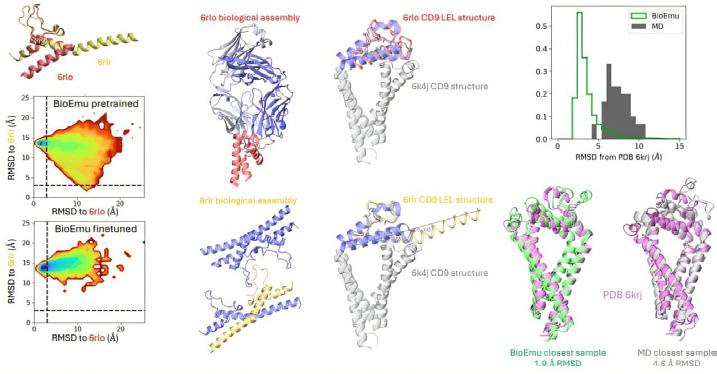
Image Credits: Science (2025). DOI_ 10.1126_science.adv9817
Microsoft’s BioEmu system models protein structural dynamics at unprecedented speed, generating thousands of structures per hour using a single GPU. It predicts thermodynamic properties and functional motions with near-lab accuracy, enabling better drug design.
Trained on the largest open protein simulation dataset, BioEmu’s tools are freely available. This scalable system, led by Frank Noé and Cecilia Clementi, offers a transformative approach to protein modeling at the genomic level.


Smart surfaces will change the way we design, create and experience the future. Our patented technology enables integrating illumination and intelligence within ultra-thin, smart surface structures and turns them into interactive experiences.
Learn more

ters
Exercise boosts mental health, but the benefit depends on context. Movement that feels rewarding— like playing with friends or joining a class—has stronger effects than routine or stressful activity.
New research shows that the social, emotional, and environmental setting matters as much as intensity or duration. For lasting mental health benefits, it’s not just about moving more—it’s about moving meaningfully.

Squats and three-minute walks every 45 minutes reduced post-meal blood sugar by 21%, outperforming a single 30-minute walk. Squats activate large muscle groups, improving glucose uptake through lactate and GLUT4 activity.
Frequent short bursts, rather than one long walk, offer better metabolic benefits. Even 20 seconds of squats can provide lasting blood sugar control, especially when repeated regularly throughout the day.

What a Heart Attack Really Feels Like
Heart attacks often present subtly—pressure, discomfort, or tightness—not the dramatic chest pain seen in movies. This misconception can delay treatment and cause more damage.




Research by Ann Eckhardt shows media shapes most people’s expectations. Shifting public and medical messaging to include vague symptoms, not just pain, could help detect heart attacks earlier and save lives.
Negative expectations about asthma predicted worse symptoms and reduced lung function over six months, regardless of stress or medication adherence. This link was based on explicit beliefs, while implicit associations showed little influence due to measurement issues.
Though limited by pandemic-related challenges, the study highlights how patient mindset can shape disease progression. Researchers suggest integrating expectation assessments into asthma care to improve treatment outcomes.






Ultra-processed foods dominate the U.S. diet, raising risks of obesity, diabetes, heart disease, and gut problems. Instead of cutting them out completely, try to reduce reliance by choosing simpler, minimally processed options with recognizable ingredients.
5
“Bad”
Foods like full-fat dairy, eggs, whole grains, potatoes, and popcorn often get a bad rap but can support weight loss when prepared mindfully. They provide protein, fiber, or resistant starch that help increase satiety.
Weight gain isn’t caused by a single food—overall diet patterns matter most. Enjoying these foods as part of a varied, nutrient-dense plan may improve satisfaction, reduce hunger, and aid in sustainable weight management.
What Happens to Your Body When You Prioritize Protein Over Carbs
Eating more protein and fewer carbs can promote fullness, stable energy, fat loss, and muscle maintenance, but may also cause fatigue, digestive issues, or strain kidneys over time.
The best approach balances whole food proteins, fiber-rich carbs, and healthy fats, tailoring intake to energy needs and longterm wellness rather than cutting carbs entirely.

Eating most calories earlier in your circadian day improves insulin sensitivity and may reduce the risk of type 2 diabetes. A study of twins found that late eaters had worse glucose metabolism and higher BMI, while eating closer to your internal clock’s “morning” offered metabolic benefits.

This rhythm-based approach doesn’t require strict fasting but emphasizes aligning meals with your body’s sleep-wake cycle. Your personal chronotype and genetics influence timing, but shifting calories earlier—especially through breakfast and lunch—can improve long-term metabolic health.





Working out in the heat can be safe with adjustments. Hydrate often, wear light clothing, avoid peak sun hours, and reduce intensity. Opt for indoor or water-based activities, and cool down thoroughly to regulate heart rate and temperature.
Add electrolytes to fluids, and ease into new routines slowly. Focus on comfort, hydration, and smart scheduling to stay active without overwhelming your body.
Functional training builds strength for real-life movement by engaging multiple muscles and joints through natural patterns like squats, lunges, and jumps. Research shows it improves strength, mobility, and coordination better than machine-based exercises.
Compound moves and multi-directional training make functional workouts more efficient and protective against injury. Whether you’re lifting weights or doing bodyweight routines, this approach strengthens your whole body for everyday performance.






Deep core exercises strengthen more than abs—they stabilize your spine, protect your lower back, and support posture. Julia Kandawire’s workout targets key muscles like the pelvic floor and diaphragm with three moves using just one dumbbell.
By focusing on control, breath, and alignment, this workout improves core strength, balance, and overall performance—while reducing injury risk. A strong midsection is about stability, not just appearance.

A medicine ball is compact, versatile, and ideal for home workouts. It boosts strength with minimal space and equipment. These five exercises—squat, overhead press, Russian twist, triceps extension, and lunge with rotation—target major muscle groups while building stability and control.
You’ll just need a mat and a weighted ball. Aim for 2–3 sets of 10–12 reps per move. Adjust intensity by changing ball weight or leverage, and focus on form to get the most from each session.

Fertility peaks in the late teens to 20s, but steadily drops with age— falling to 75% by age 30 and 44% by 40. Unlike men, who produce new sperm regularly, women are born with a finite number of aging eggs.
Beyond age, fertility is affected by lifestyle, genetics, and environmental factors. Yet, many women remain unaware of these risks. Experts urge earlier education to support informed choices and potentially preserve fertility before problems arise.
A Nature Cardiovascular Research study from Karolinska Institutet found women with PMS or PMDD have a 10% higher risk of cardiovascular disease. Particularly, risks for arrhythmias and stroke rise by 31% and 27%, respectively. This connection holds even after adjusting for smoking, BMI, and mental health.
Researchers suggest hormonal disruptions, inflammation, and metabolic abnormalities as possible causes. The study highlights that early diagnosis, especially before age 25 or with postnatal depression, indicates even greater risk. Authors Yihui Yang and Donghao Lu call for increased awareness of these long-term health impacts.

High blood pressure, often silent, affects millions of women and is frequently misdiagnosed due to subtle symptoms, hormonal shifts, and societal biases. Key risk factors include aging, menopause, pregnancy complications, certain contraceptives, family history, and lifestyle habits.
Managing hypertension involves regular monitoring, lifestyle changes like healthy eating and exercise, and sometimes medication. Banner Health offers personalized care focused on women’s unique needs, helping prevent life-threatening complications like heart disease and stroke.






New research from SWAN highlights that only 21% of midlife women meet ideal cardiovascular health scores per Life’s Essential 8. Sleep, alongside blood glucose, blood pressure, and nicotine use, is pivotal for long-term heart health.


Country: Spain

Pelvic floor therapy is gaining attention among men for more than sexual wellness. A hypertonic pelvic floor can cause urinary issues, erectile dysfunction, and constipation. Treatments involve exercises, stretches, and muscle relaxation techniques led by trained physical therapists.
With rising awareness from urologists and online platforms, men now seek therapy to manage chronic pain, urinary problems, and post-surgery recovery. This holistic approach helps improve daily comfort, boost sexual function, and promote long-term health.





New research from the FAME 2.0 study presented at ENDO 2025 identifies modest increases in blood sugar, not just age or testosterone decline, as key drivers of reproductive and sexual changes in men.
Tracking healthy men aged 18-85, researchers found minor elevations in blood sugar—below diabetic thresholds—were linked to reduced sperm motility and erectile function, while testosterone primarily affected libido. These findings suggest healthier metabolic control can help men sustain sexual well-being into older age.


A study of 1,543 North American males (15–35) found those using medications like Ozempic or Wegovy were likelier to report disordered eating. Despite low usage rates (1.2%), users showed greater eating disorder symptoms, often linked to body image pressures.
Researchers urge more awareness around these drugs’ mental health effects, especially with rising off-label use. Boys and young men, often overlooked in body image discussions, face unique risks requiring better screening and education.
Today’s Indian men silently struggle with rising stress, low energy, and hormonal imbalances. Ayurveda offers natural, long-term solutions through herbs like Shilajit and Ashwagandha. Backed by clinical research, these adaptogens enhance testosterone, stamina, and stress recovery—promoting energy without crashes.
With 46% of men facing lifestyle diseases and fertility drops, Ayurveda focuses on prevention over quick fixes. Experts like Dr Govindarajan advocate building strength and resilience naturally, helping modern men balance ambition with lasting vitality.

Researchers from SAHMRI and the University of Washington have found that extended anticholinergic drug use, common in treating COPD, depression, and Parkinson’s, can worsen physical mobility in older adults. These medications suppress acetylcholine, a key neurotransmitter, leading to slower walking speeds and potential cognitive decline, especially with high-dose, long-term use.
Involving 4,283 adults from the Adult Changes in Thought study, the research revealed significant declines in gait speed after surpassing 1,096 daily doses within a decade. While grip strength remained mostly unaffected in the long term, recent high-dose users also experienced weakened grip, prompting calls for cautious use and routine medication reviews in older patients.






New research on 228 Chinese wheat varieties shows wheatgrass flavonoids can fight oxidative stress and lengthen fruit fly lifespans, especially in males. High-flavonoid cultivars combined with jasmonic acid treatment notably increased antioxidant levels and improved bioactivity.
These findings identify wheatgrass as a potent source of beneficial flavonoids, surpassing mature wheat grains in antioxidant power. This opens pathways for creating functional foods to address aging and stress-related diseases while guiding breeding programs towards high-flavonoid, health-promoting wheat cultivars.
A study at ENDO 2025 highlights that people older than 80 who suffer fractures should receive osteoporosis treatment to lower hospitalization and mortality. Using the TriNextX database, researchers tracked 88,676 patients, finding those treated with medications like bisphosphonates and denosumab had better outcomes over five years.
These findings support targeted treatment to reduce complications and improve quality of life in the aging population.
Image
Genetically Enhanced Stem Cells Show Multi-System Anti-Aging Effects
Scientists have engineered senescence-resistant mesenchymal progenitor cells (SRCs) using FOXO3 gene editing, enabling these cells to resist aging, avoid tumors, and survive stress. In macaques, biweekly SRC injections over 44 weeks reversed aging signs across ten major body systems, enhancing brain function, bone strength, and reproductive health without adverse effects.
SRCs work through direct regeneration and exosome release, improving cellular health and reducing inflammation. This study represents the first evidence of safe, system-wide rejuvenation in primates, paving the way for human trials and offering a new direction for tackling age-related decline through multi-target regenerative medicine.

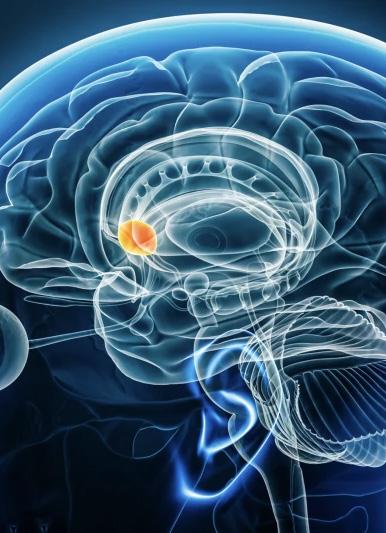
Dopamine signals the brain through precise, ultra-fast bursts targeting specific neurons rather than broad, continuous release. This refined understanding overturns old beliefs and may improve treatments for neurological and psychiatric conditions like Parkinson’s and ADHD.
By acting both in localized bursts and slower broad diffusion, dopamine fine-tunes behaviors and complex brain functions, opening avenues for new therapies tailored to how dopamine truly works in the brain.

Sighing before speaking signals emotional tension, stress, or mental fatigue. It often marks the release of strong feelings, prepares the speaker to express something difficult, or resets breathing during anxiety.
This subtle gesture also serves as a silent communication cue, indicating that what follows is important or emotionally charged. Whether from cognitive overload, relief, or physical exhaustion, a sigh reveals underlying states worth recognizing.
Exercise distorts time perception by altering internal brain pacemakers and sensory attention, making moments feel longer. This involves basal ganglia oscillations linked to movement and reward circuits.




Studies with recreational cyclists show that competition doesn’t change this effect, which fades quickly after exertion. Understanding this helps athletes calibrate pacing using external cues, not just internal feelings, improving training and performance strategies.
Advanced MRI combined with the Julich-Brain Atlas reveals widespread reductions in brain volume related to emotion and control in individuals with psychopathy, emphasizing a biological basis for antisocial behavior. Researchers found that antisocial traits correlate with reduced volumes in subcortical, cortical, and brainstem regions involved in emotional regulation and impulse control. While interpersonal-affective traits showed weaker brain volume associations, total brain volume was significantly lower in psychopathy, especially in the hippocampus. These findings strengthen the neurobiological understanding of antisocial behavior and aggression, guiding future research under the SFB TRR 379 initiative.



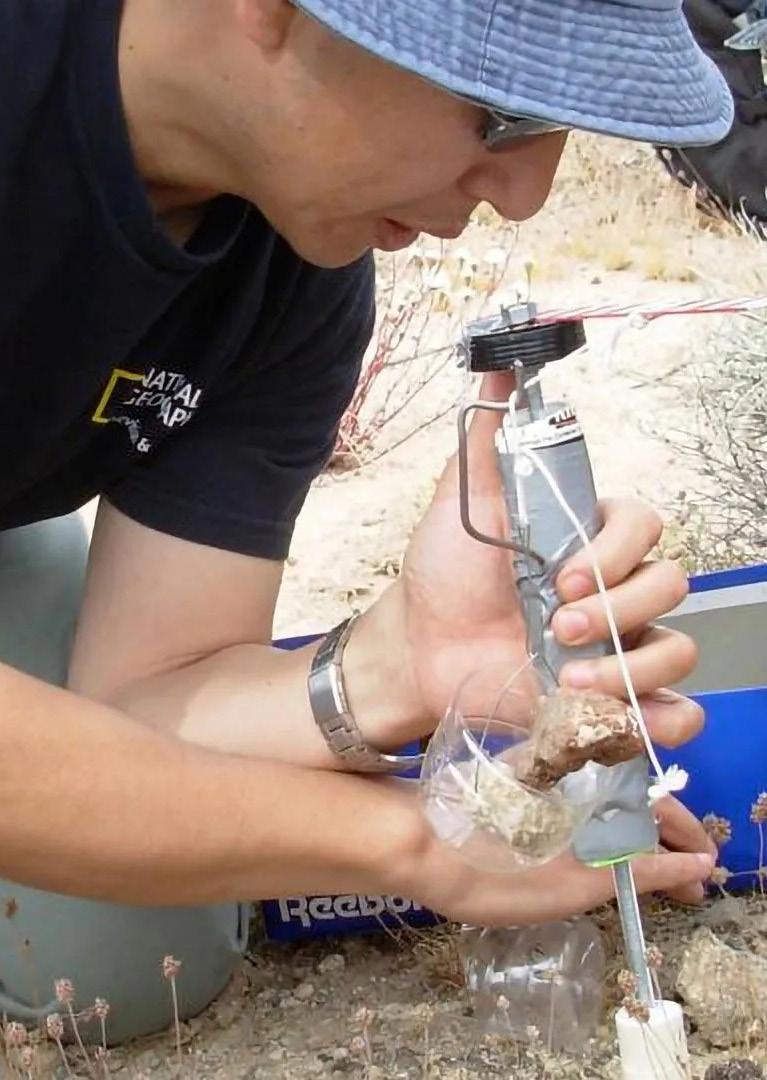
A humble lichen from the Mojave Desert just expanded our definition of survivability in space! This blacktinted Clavascidium lacinulatum isn’t just tough—it withstood three months of deadly UVC radiation that would normally sterilize life. Its secret? A microscopic “sunscreen” layer that shields vital cells, acting like nature’s ultimate radiation armor.
Scientists now believe that Earthlike exoplanets orbiting volatile stars may still support life—especially tan, colony-loving microorganisms that shrug off cosmic stress.



July 11
Historical Events:
1979 – Skylab Reenters Earth’s Atmosphere: Skylab, the United States’ first space station, reentered the atmosphere after six years in orbit. Launched in 1973, Skylab hosted three crewed missions and yielded significant data on longterm human habitation in microgravity, solar astronomy, and biomedical effects of spaceflight. Its reentry sparked discussions on orbital debris and led to better planning for future space station de-orbiting protocols.
2006 – Launch of Discovery on STS-121 to the ISS: This Space Shuttle mission was a returnto-flight test following the Columbia disaster. It tested new safety procedures and carried logistics and equipment to the International Space Station. STS-121 played a crucial role in reaffirming the viability of human spaceflight and refining operational standards for orbital docking and EVA (extravehicular activity).
Scientist Anniversaries:
1916 – Birth of Alexander Prokhorov: Russian physicist who shared the Nobel Prize in Physics in 1964 for pioneering research in quantum electronics, specifically for work on masers and lasers. His contributions led to major advances in microwave spectroscopy, optical communication, and photonics, which
form the basis of laser surgery, telecommunications, and quantum computing.
1927 – Birth of Theodore Maiman: American physicist and inventor of the first operational laser in 1960, using a synthetic ruby crystal. Maiman’s laser marked the dawn of the laser era, enabling transformative innovations across industries including medicine, fiber optics, barcode scanning, materials processing, and telecommunications.
Scientific Discoveries:
2012 – Curiosity Rover Captures Images of Martian Clouds: NASA’s Mars Science Laboratory rover Curiosity recorded high-resolution images of noctilucent clouds drifting across the Martian sky. These observations added important data about atmospheric dynamics, water ice condensation, and climate cycles on Mars.
2000 – Sequencing of the Arabidopsis thaliana Genome: The complete sequencing of the genome of Arabidopsis thaliana, a model organism in plant biology, was finalized. It was the first plant genome to be fully sequenced, allowing scientists to study gene regulation, plant-pathogen interaction, and evolutionary genetics with an unprecedented level of detail.
July 12
Historical Events:
1967 – Launch of Explorer 35 to Study the Moon’s Magnetosphere: Explorer 35 was placed into a lunar orbit to investigate solar wind, magnetic fields, and plasma near the Moon. The data helped confirm the Moon has no significant global magnetic field and contributed to our knowledge of how solar and cosmic radiation interacts with non-magnetized celestial bodies.
2000 – Launch of Zvezda Module to the ISS:
The Russian-built Zvezda service module was launched and later docked with the International Space Station. Zvezda provided critical life support systems, living quarters, and propulsion for orbit maintenance. Its integration marked the true beginning of long-term human habitation aboard the ISS and expanded international collaboration in space technology.
Scientist Anniversaries:
1928 – Birth of Elias Corey: American organic chemist and recipient of the Nobel Prize in Chemistry in 1990 for his development of the theory and methodology of organic synthesis. Corey’s retrosynthetic analysis revolutionized drug design and natural product synthesis, influencing nearly every area of pharmaceutical chemistry.
1936 – Birth of Richard Lynn Garwin: American physicist and polymath who worked on early
computing, laser physics, gravitational wave detection, and magnetic resonance. He played an instrumental role in developing MRI technology and was involved in foundational discussions on quantum measurement and information theory.
Scientific Discoveries:
2015 – Pluto’s “Heart” Region Imaged for the First Time: New Horizons captured detailed images of a large, heart-shaped glacier region on Pluto, later named Tombaugh Regio. These images revealed nitrogen ice flows, cellular terrain, and a lack of impact craters, suggesting geologic activity and reshaping scientific understanding of small icy worlds.
2019 – First Direct Observation of a Black Hole’s Magnetic Field Lines: Using polarimetric data from the Event Horizon Telescope, astronomers were able to trace the magnetic field lines surrounding the supermassive black hole in the galaxy M87. These observations supported theoretical predictions about how magnetic fields channel jet formation and influence black hole accretion physics.
July 13
Historical Events:
1974 – First Use of a Geosynchronous Weather Satellite for Real-Time Forecasting: The GOES1 satellite, launched by NASA and operated by NOAA, began providing

continuous imagery of Earth’s atmosphere. Positioned in a geosynchronous orbit, it allowed meteorologists to monitor the development of weather systems like hurricanes, thunderstorms, and jet streams in real-time. This marked a transformative step in forecasting accuracy and disaster preparedness, particularly for early warning systems related to severe weather events.
2011 – NASA’s Dawn Spacecraft Enters Orbit
Around Vesta: Dawn became the first spacecraft to orbit a protoplanet in the asteroid belt. Its mission was to study Vesta’s surface composition, topography, and internal structure. Findings revealed evidence of ancient volcanic activity, massive impact basins, and differentiated layers, offering valuable insights into the early formation of rocky bodies in the solar system.
Scientist Anniversaries:
1826 – Birth of Stanislao Cannizzaro: Italian chemist best known for his role in the development of atomic weights and modern chemical formulas. At the Karlsruhe Congress in 1860, he revived Avogadro’s hypothesis, which clarified the distinction between atoms and molecules, directly influencing the modern Periodic Table. His methods became fundamental in chemical education and quantitative analysis.
1926 – Birth of Robert H. Dennard: American electrical engineer and inventor of dynamic random-access memory (DRAM). His 1968 invention became the basis for the memory used in nearly all modern computers, revolutionizing data storage, computing architecture, and miniaturization of electronic devices.
Scientific Discoveries:
2004 – First Detection of Acetylene in a Protoplanetary Disk: Using NASA’s Spitzer Space Telescope, astronomers identified complex organic molecules such as acetylene and hydrogen cyanide in the disks of gas and dust surrounding young stars. This was one of the earliest proofs that key chemical precursors to life could form in planet-forming regions, contributing to the field of astrochemistry and the study of planetary system development.
2016 – Scientists Announce Discovery of an Ultra-Faint Galaxy Orbiting the Milky Way: Researchers using the Dark Energy Survey identified a satellite galaxy named Horologium II. Its extremely low luminosity and high dark matter content added data to theories of galactic formation and the structure of dark matter halos.
July 14
Historical Events:
1965 – Mariner 4 Transmits the First Close-Up
Images of Mars: NASA’s Mariner 4 became the first spacecraft to successfully fly by Mars and send back photographs of its surface. The images revealed a cratered, moon-like landscape, dispelling earlier assumptions of Martian vegetation or canals. This mission marked a turning point in planetary science and gave humanity its first close look at the surface of another planet.
2015 – NASA’s New Horizons Makes Closest Approach to Pluto: After traveling over 3 billion miles, New Horizons completed a successful flyby of Pluto, capturing unprecedented high-resolution images and data. It revealed mountain ranges of water ice, nitrogen glaciers, and atmospheric haze layers, challenging prior assumptions of small icy bodies being geologically inert. The mission dramatically expanded knowledge about the Kuiper Belt and planetary geology.
Scientist Anniversaries:
1865 – Birth of Florence Bascom: American geologist and pioneering woman in the field, Bascom was the first woman hired by the U.S. Geological Survey and among the first to earn a PhD in geology. Her work on crystalline rocks and the Appalachian Mountains helped establish modern petrology and structural geology.
1942 – Birth of Martin
Rees: British cosmologist and astrophysicist who made key contributions to galaxy formation, quasars, black holes, and the large-scale structure of the universe. As Astronomer Royal and former president of the Royal Society, Rees has helped bridge astrophysics with public understanding of science.
Scientific Discoveries:
2009 – Discovery of Fast Radio Burst (FRB 090625): Detected by the Parkes Radio Telescope, this burst was one of the early confirmed instances of a fast radio burst, a powerful yet extremely brief radio pulse of unknown origin. The phenomenon remains one of the most enigmatic in astrophysics and has stimulated global efforts to detect and characterize FRBs.
2014 – First Imaging of an Exoplanet Atmosphere Using Polarimetry: Using advanced polarimetric techniques, scientists managed to isolate the atmospheric signal from the exoplanet HD 189733b, offering insights into its albedo, scattering particles, and cloud structure. This breakthrough method contributed to the future of atmospheric analysis in exoplanetary research. July 15
Historical Events:
1975 – Apollo–Soyuz Test Project Begins: Although technically involving collaboration, the mission had major scientific

goals. It was the first international crewed space mission, testing docking mechanisms, joint procedures, and long-duration spaceflight effects. The project contributed to standardization of docking systems and helped pave the way for future international space stations like the ISS.
2006 – Launch of CALIPSO Satellite to Study Atmospheric Aerosols and Clouds: The joint NASA-CNES CALIPSO satellite began profiling Earth's clouds and aerosols using lidar and infrared sensors. The data has been vital for understanding the role of aerosols in climate forcing, energy balance, and weather prediction, improving models of climate change and environmental forecasting.
Scientist Anniversaries:
1921 – Birth of Geoffrey Wilkinson: British chemist who shared the Nobel Prize in Chemistry in 1973 for work on organometallic compounds, particularly sandwich compounds like ferrocene. His research had deep implications in industrial catalysis, materials science, and the development of advanced synthetic techniques.
1963 – Birth of Mark Gasson: British cybernetics researcher known for his work on implantable technologies and biohacking. He was the first person to be infected by a computer virus via an implanted RFID chip,
raising early ethical and cybersecurity questions about human enhancement and cyber-biological interfaces.
Scientific Discoveries:
2000 – Discovery of the First Neutrino Oscillations by Super-Kamiokande: The Japanese Super-Kamiokande detector announced definitive evidence that neutrinos oscillate between different flavors, implying they have mass. This was a breakthrough in particle physics, requiring modification of the Standard Model and informing both cosmology and solar physics.
2013 – First Precise Mapping of Milky Way’s Spiral Arms Using Parallax: By combining data from radio telescopes observing masers around young stars, astronomers created the most detailed 3D map of the Milky Way’s structure. This refined our understanding of galactic dynamics, stellar formation zones, and spiral arm motion.
July 16
Historical Events:
1945 – First Nuclear Fission Explosion (Trinity Test): Conducted by the Manhattan Project team in the New Mexico desert, this was the first detonation of a nuclear device. The test validated the feasibility of nuclear chain reactions releasing massive amounts of energy, marking the dawn of the Atomic Age. From a scientific standpoint, it confirmed theoretical
predictions about fission behavior under compression and extreme conditions. It also initiated decades of research into nuclear physics, radiation shielding, reactor design, and radiobiology, while prompting the emergence of nuclear medicine and nuclear-powered spacecraft concepts.
1994 – Comet Shoemaker-Levy 9 Collides with Jupiter: This rare astronomical event offered scientists an unprecedented opportunity to study planetary impacts in real-time. As fragments of the comet struck Jupiter's atmosphere, they left dark scars visible from Earth and produced massive plumes of debris. The event allowed researchers to test impact models, examine the Jovian atmosphere’s chemical layers, and understand the dynamics of cosmic collisions that could affect other celestial bodies, including Earth.
Scientist Anniversaries:
1906 – Birth of Reinhold Mannkopff: A German physicist known for his postwar contributions to high-altitude aerodynamics and jet propulsion systems. While lesser known than others, Mannkopff was among the scientists who helped advance wind tunnel testing techniques, greatly improving aircraft efficiency and atmospheric reentry calculations for space vehicles.
1926 – Birth of Irwin Rose: An American biologist and Nobel laureate in Chemistry (2004) for his work on ubiquitin-mediated protein degradation. His discoveries laid the foundation for understanding how cells control protein quality and quantity, a process vital in cancer, neurodegenerative disorders, and autoimmune diseases. The ubiquitin-proteasome system is now a target for novel drug therapies.
2000 – Discovery of Evidence for Ancient Lakes on Mars (Mars Global Surveyor): NASA announced findings that supported the past presence of liquid water on Mars, based on erosional features and sediment deposits observed by the Mars Global Surveyor. These insights dramatically expanded the search for habitable conditions and past life on the Red Planet, spurring follow-up missions like Curiosity and Perseverance.
2016 – Scientists Identify the Youngest Known Galaxy (EGS-zs8-1): Using Hubble and Spitzer data, astronomers confirmed a galaxy formed just 670 million years after the Big Bang. Its high star-formation rate and ultraviolet emission offered rare information about early galactic formation, enriching cosmological models of the reionization epoch.

Pebbles on Iceland’s shores reveal a sixth-century cold snap, the Late Antique Little Ice Age, driven by volcanic eruptions in 536-547 AD. Transported by Greenlandic icebergs, these rocks show cooler summers, widespread crop failures, and shifting ocean currents. This climate shock destabilized the Roman world, worsening famine and disease, including the Justinian Plague. Zircon analysis traced the pebbles’ origins to Greenland, confirming iceberg drift across 800 miles. Shoreline data aligns with marine records, showing how climate disruptions rippled through food, trade, and migration networks—a pattern still relevant in today’s volatile climate.
Image Credits: Guo, Institute of Vertebrate Paleontology and Paleoanthropology (IVPP)
Fossils in Burmese amber reveal that Paleoophiocordyceps fungi infected ants and flies nearly 100 million years ago, using behavior-manipulating strategies seen in modern zombie fungi. These parasites influenced insect evolution by controlling host behavior and adapting to shifting insect hosts like beetles, flies, and ants during the Early Cretaceous.
Amber preserves these fungi’s delicate reproductive structures, providing rare insight into ancient disease ecology. Understanding this deep evolutionary history aids modern bio-pesticide development and forecasts fungal pathogen responses to climate change, highlighting fungi’s role in shaping ecosystems past and present.

Archaeologists from the University of Houston uncovered the tomb of Te K’ab Chaak, the first ruler of Caracol, Belize’s largest Maya site. Buried with pottery, jadeite, and symbolic artifacts, his tomb reflects elite status and early links to central Mexico. This discovery is the first confirmed ruler’s tomb found at Caracol in over 40 years.
Additional burials with Teotihuacan-style artifacts, including green obsidian and atlatl points, suggest strong cross-cultural exchanges before 378 AD. These findings show Caracol’s rulers were key players in Mesoamerican networks, with Te K’ab Chaak’s dynasty enduring for over 460 years.
Image Credits: Caracol Archeological Project_University of Houston

Yinshanosaurus angustus, a late Permian pareiasaur from China, offers rare insight into pre-extinction ecosystems. Discovered by Dr. Jian Yi and Dr. Jun Liu, its unique skull, teeth, and skeleton reveal key traits of plant-eater evolution before Earth’s largest mass extinction. CT scans showed distinct cranial features and lifelong tooth replacement. Closely related to Shihtienfenia, it helps scientists trace how climate and habitat changes shaped ancient life before the end-Permian collapse.





Image Credits:
New research led by Djuna Croon suggests dark matter could be detected via “dark dwarfs”—brown dwarfs that trap dark matter, leading to energy release. Unlike regular brown dwarfs, they retain lithium-7, offering a clear observational clue.
If discovered, dark dwarfs would offer crucial evidence for the existence of heavy, self-interacting dark matter, possibly weakly interacting massive particles (WIMPs). Detecting them, especially near the galactic center, could clarify dark matter’s true nature and validate longstanding cosmological theories.
Image Credits: NASA, ESA, CSA, STScI
Since July 2022, NASA’s James Webb Space Telescope has revealed hidden star-forming regions like the Cat’s Paw Nebula (NGC 6334), unveiling intricate “toe beans” of gas and dust 4,000 light-years away. With unmatched infrared precision, Webb’s NIRCam captures newborn stars and dense clouds, deepening our understanding of stellar nurseries and galactic evolution.








Image Credits: ALMA(ESO_NAOJ_ NRAO)_A. Ribas et al
Hidden Gas Giant Found Around Young Star Using New Techniques
Astronomers have found a giant exoplanet—three to ten times Jupiter’s mass—hiding in the protoplanetary disk of MP Mus. Earlier studies showed no planetary signs, but new observations from ALMA and Gaia revealed a large gas giant inside a cavity in the disk, causing the star’s wobble. This is the first time Gaia has helped find a young planet in a disk. Combining Gaia’s star movement data with ALMA’s deep disk imaging suggests more hidden planets could exist, offering crucial insights into how solar systems, including our own, may have formed.
How the International Space Station Revolutionizes Space Research and Human Health
The International Space Station (ISS) is a groundbreaking microgravity lab orbiting Earth, allowing experiments impossible on the ground. It hosts studies in fluid dynamics, combustion, and biological processes, with human astronauts adjusting and maintaining experiments in real time. Its unique vantage point enables constant monitoring of Earth and space phenomena.
Long-term ISS research has revealed how microgravity alters the human body, such as vision changes from fluid shifts. Extended missions generate critical insights into health, materials science, and safety, advancing both space exploration and improving life on Earth.
Image Credits: WikiImages from
Image Credits: Joseph Humphreys, University of Leeds
Michael Yip of UC San Diego envisions humanoid robots easing burdens in surgery by handling routine tasks like camera-holding and instrument-passing. By adapting industrial AI advances and adding arms and hands to surgical robots, hospitals could reduce staff burnout and procedure delays.
Instead of specialized robots for every task, Yip promotes general-purpose humanoid robots that learn diverse skills. While widespread adoption is years away, these adaptable robots could transform healthcare efficiency and help combat global medical staff shortages.





A breakthrough study by University of Leeds and UCL developed a bio-inspired AI framework enabling robots to instinctively adjust their gait, like animals, without human guidance. Trained entirely in simulation, the robot “Clarence” mastered rapid gait transitions within nine hours and successfully navigated unfamiliar, uneven real-world terrains without further adjustments.
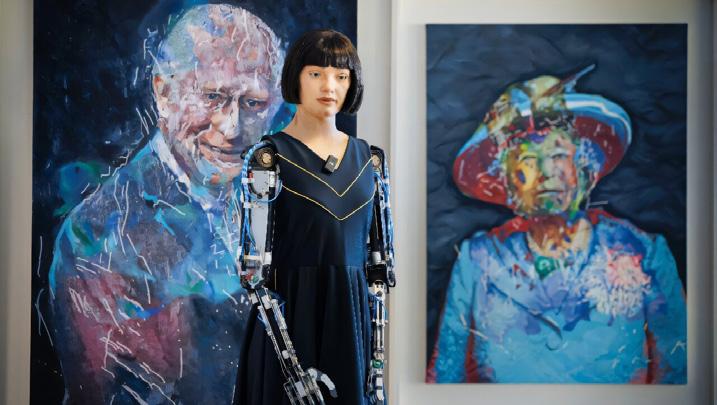

AI Artistry: Ethical Innovation and Creative Dialogue
Ultra-realistic robot Ai-Da unveiled Algorithm King, a portrait of King Charles, emphasizing it won’t replace human artists but aims to provoke ethical discussions about AI. Using advanced algorithms, AiDa celebrates the King’s environmental and interfaith efforts while questioning AI’s evolving role in creative expression.
Created by Aidan Meller with Oxford and Birmingham specialists, Ai-Da highlights AI’s transformative power but insists on encouraging responsible innovation without overshadowing human artistry.
Quantum materials like tantalum disulfide (1T-TaS₂) enable ultrafast switching between insulating and metallic states via thermal quenching, achieving phase changes in picoseconds. This breakthrough could accelerate processors from gigahertz to terahertz speeds and drastically reduce energy consumption compared to silicon.
By stabilizing metallic domains at high temperatures and extending their lifetime by twelve orders of magnitude, researchers envision 3D stacked devices that integrate memory, logic, and communication. Overcoming challenges like thin-film stability and heat management will pave the way for ultrafast, energy-efficient computers beyond silicon’s limits.


Twice the volume of traditional five-meter class fairings means room for bigger constellations and larger payloads.
Hydrogen-powered upper stage designed for demanding, highly energetic missions to low Earth orbit (LEO), medium Earth orbit (MEO), and geosynchronous orbit (GEO).
Built on New Shepard’s BE-3PM flight heritage, the BE-3U is optimized to operate in the vacuum of space. Its high thrust and high specific impulse enable New Glenn’s upper stage to accomplish a wide variety of missions.
Four actuated aerodynamic control surfaces for attitude adjustment during the first stage’s descent and landing.
Designed for reuse and minimal maintenance in between flights.
Wing-like to provide lift and cross-range for the reusable first stage during its descent back to Earth.
Aft module houses six hydraulically-actuated legs to support and secure the first stage during landing on a moving platform.


Multiverse:
A hypothetical concept suggesting that our universe is one of many, each with different physical laws or conditions. It arises from theories in cosmology, quantum mechanics, and string theory.
What if you could see a woolly mammoth stomping through the snow, hear the screech of a dodo bird in the trees, or marvel at a living, breathing saber-toothed cat? No, this isn’t the plot of a new Jurassic Park sequel (though we’d definitely watch that). This is the rapidly evolving science of de-extinction—the attempt to bring vanished species back from the abyss of time using the most advanced tools in biotechnology. It sounds like science fiction, but it’s edging closer to science fact.
In this edition of Curiosity, we dig deep (like archaeologists in lab coats) into the thrilling, slightly bonkers, and very real world of de-extinction. What does it mean to bring a species back from extinction? Is it ethical? Feasible? Useful? Dangerous? And are we really about to share the planet again with mammoths?
What Is De-Extinction? De-extinction refers to the process of reviving extinct species using genetic technologies. Think of it as molecular necromancy, but instead of waving a wand, scientists use CRISPR, DNA sequencing, and a whole lot of pipettes. There are three main methods being explored:
• Back-Breeding: Selecting and breeding living species with traits similar to the extinct one. This is more about reconstructing something like the extinct animal rather than cloning it outright.
• Cloning: Using preserved DNA from extinct animals and inserting it into the egg of a related species.
• Genetic Engineering: Editing the genome of a living species to include genes from an extinct one. Think elephant + mammoth genes = a shaggy, cold-resistant pachyderm.
While the first method is more traditional and less precise, the latter two involve cutting-edge genetic science and the dream of true biological resurrection.
The Stars of De-Extinction
Let’s talk about the headliners of this hightech resurrection show: Woolly Mammoth: Arguably the poster child for de-extinction. The mammoth went extinct around 4,000 years ago, but many of its remains have been preserved in Siberian permafrost. Scientists are working to insert mammoth genes into Asian elephants to create a hybrid that can survive Arctic conditions.

• Passenger Pigeon: Once numbering in the billions, these birds vanished in the early 1900s. By editing the DNA of the closely related band-tailed pigeon, researchers hope to recreate a modern version of the passenger pigeon.
• Tasmanian Tiger (Thylacine): This
striped marsupial carnivore was declared extinct in the 1930s. With preserved specimens and related species like the Tasmanian devil still around, it’s a candidate for genetic revival.
• Dodo: This famously unfortunate flightless bird from Mauritius disappeared in the

17th century. Advances in ancient DNA extraction are reigniting hopes of bringing the dodo back.
• Aurochs: The massive wild ancestor of domestic cattle. Back-breeding programs have been trying to bring aurochs-like traits back into modern cattle.
The Science Behind the
Let’s not sugarcoat it: De-extinction is mind-bendingly complex.
The first hurdle is DNA. Even the best-preserved specimens have degraded DNA, often broken into fragments. Scientists must piece these fragments together like a 3D jigsaw puzzle, often using the genome of a
closely related living species as a scaffold.
Enter CRISPR-Cas9, the molecular scissors that let scientists cut and paste genes with high precision. By editing specific genes associated with traits like fur, fat storage, or beak shape, researchers can reintroduce traits of extinct animals into the DNA of living relatives.
Once the edited genome is ready, it must be placed inside a viable egg cell, implanted into a surrogate mother, and successfully brought to term. Each step comes with enormous technical and ethical challenges. In some cases, scientists use somatic cell nuclear transfer, the same method used to clone Dolly the sheep. This involves taking the nucleus from a cell of the extinct species and inserting it into an egg cell from a living relative. The embryo is then stimulated to divide and is implanted into a surrogate.
Why Bring Back Extinct Species?
Great question. The reasons fall into several camps:
Ecological Restoration: Some extinct species were keystone species—organisms that had a disproportionately large impact on their ecosystems. Reintroducing them might help restore ecological balance. For instance, mammoths
could help slow Arctic permafrost melt by trampling down snow and promoting grassland.
• Scientific Curiosity: Because why not? The process of de-extinction teaches us an incredible amount about genetics, development, and evolution.
Redemption: Many extinctions were human-caused. De-extinction might be a way to right historical wrongs.
• Biotechnological Spin-offs: Techniques developed for de-extinction often lead to breakthroughs in related fields, like gene therapy or conservation biology.
Cultural Value: Some species, like the dodo or mammoth, hold deep cultural significance and fascination. Their revival could inspire public interest in biodiversity.
Of course, not everyone is shouting “Jurassic Yes!” from the rooftops.
• Welfare of De-Extinct Animals: Will these animals suffer? Will they have a place to live? Will they be socialized or isolated oddities?
Ecological Disruption: Introducing new (or old) species into modern ecosystems could lead to unex-
pected consequences, like competition with existing species or disease spread.
Resource Allocation: Could the money and brainpower spent on de-extinction be better used protecting species that are endangered now?
• Slippery Slope: Do we risk creating a world where extinction is seen as reversible and thus less tragic?
• Playing God: Some argue that humans should not interfere with natural processes at this scale.
Surprising Realities and Challenges
You Can’t Resurrect What You Don’t Fully Understand: For many extinct species, we lack detailed knowledge of their behavior, diet, and ecology. What if we bring back a species that can’t survive in the wild because the world has changed too much?
Extinction Isn’t Static: DNA continues to degrade over time, so species that went extinct more recently are more viable candidates than dinosaurs (sorry, T. rex fans).
Hybrid Dilemmas: Most de-extinct animals won’t be perfect clones. They’ll be hybrids, part new, part old. This raises
philosophical questions: are they truly the same species?
• De-Extinct Zoos?: Could zoos house and breed de-extinct animals? Would that serve education and conservation, or be a novelty sideshow?
• Rewilding Projects: Some scientists envision releasing de-extinct animals into the wild to recreate lost ecosystems, but such plans require massive preparation, protected areas, and long-term monitoring.
Pop Culture vs. Reality
Movies like Jurassic Park have given the public some ideas about de-extinction—some accurate, many exaggerated. No, we can’t bring back dinosaurs from blood in amber (yet). Yes, it’s risky. But unlike the rampaging T. rex scenario, most real-world projects are focused on species that disappeared within the last 10,000 years and have living relatives today.
Still, public fascination with de-extinction helps fund research and spark debate. And who wouldn’t want to see a real mammoth (from a safe distance)?
The ethical questions raised in Jurassic Park— Who is responsible? What happens when control is lost?—remain relevant even when the species in question is a pigeon rather than a raptor.
How Close Are We Really?
Closer than you might think. Mammoth-elephant hybrid embryos have already been created in labs. The startup Colossal Biosciences claims it could have the first mammoth hybrid calf within a decade.
Passenger pigeon genes have been successfully inserted into living pigeons. Thylacine DNA is being sequenced with high resolution. The toolbox is growing, and the pace of progress is accelerating.
Recent breakthroughs in synthetic biology and reproductive cloning have added fuel to the fire. Artificial wombs, once a concept of science fiction, are now being tested for other animals and could remove the need for living surrogates altogether.
Still, don’t expect a fullscale Pleistocene Park anytime soon. Growing a population, establishing ecological balance, and ensuring the animals’ health all take time.
A Future with Rewilded Ghosts?
Conservationists are split. Some see de-extinction as a distraction from urgent threats like habitat loss and climate change. Others see it as a tool that, if used wisely, could complement traditional conservation efforts.
Conclusion: Between Ambition and Caution
So next time you see a pigeon, just remember: its ancestor might be making a comeback, feather by feather, gene by gene. And if a woolly mammoth ever lumbers past your window, well... don’t say we didn’t warn you.
Bringing species back from extinction forces us to question not just what we can do, but what we should do. It’s an exploration of our scientific prowess, ethical maturity, and ecological responsibility. As we stand at this crossroad of biology and technology, one thing is certain: the age of resurrection science has only just begun.
Imagine a world where mammoths roam Siberia, dodos waddle across Mauritius, and thylacines prowl the Tasmanian bush. This isn’t just about nostalgia. It’s about confronting our role in the planet’s past and taking bold steps into its future. De-extinction is controversial, complex, and full of unknowns. But it also captures the imagination and opens new avenues in science and conservation. Whether you view it as reckless or revolutionary, one thing is clear: the line between extinction and existence is blurrier than ever before.
Starting motherhood at 44 felt late, but years of healing and growth have made me ready in ways youth never could. Friends’ stories of becoming parents at various ages reminded me readiness isn’t age-dependent but about being whole and present. Now, I’m prepared to nurture my son with patience, values, and unconditional love. Age brings unique gifts, and every parenting journey is valid—what truly matters is showing up fully for the moment.
A University of Michigan study reveals that unwavering spousal support is crucial for African American couples married over 20 years. Couples describe their marriages as supportive havens with few conflicts, influenced by factors like gender, education, and income. Men tend to receive more support, while women report slightly more negative interactions. Notably, remarriage does not increase difficulties, challenging common assumptions. These findings offer a balanced and positive perspective on long-term African American marriages, with implications across all races.





Starting motherhood at 44 felt late, but years of healing and growth have made me ready in ways youth never could. Friends’ stories of becoming parents at various ages reminded me readiness isn’t age-dependent but about being whole and present.

I moved away from my parents in my 20s, and now that they’re older, I feel guilty about not living nearby. Though technology helps us stay connected, nothing replaces being close. This struggle to balance independence with caregiving is common, underscoring the importance of cherishing family time despite physical distance.



Oil is in nearly every product we use, and savvy investors are taking note. Many accredited investors are now including oil and gas partnerships in their IRAs for added diversification, stable cash flow and higher return potential.
Though not risk-free, these partnerships often yield 8%–12% quarterly cash flow and target 15%–20% annual returns. With proper due diligence and the right adviser, oil and gas can boost retirement income beyond traditional investments.
AI Will Amplify, Not Replace,
AI is transforming financial advice—not by replacing advisers but by removing the grunt work. Tools like Morgan Stanley’s GPT4 assistant and BofA’s Erica are streamlining tasks, freeing advisers to focus on complex strategies and emotional insight.
As firms integrate AI into workflows, success will hinge on blending technology with human wisdom. In the end, trust remains the foundation of financial advising—now enhanced, not erased, by intelligent tools.
Decluttering Your Finances: A Smarter Way to Save
Decluttering your financial life can reduce waste, cut impulsive spending, and create room for smarter decisions. Streamlining accounts, canceling unused subscriptions, and organizing key documents boosts clarity and long-term savings.
By regularly reviewing your finances, you’ll minimize stress, avoid costly mistakes, and build habits that support intentional money management. Less clutter equals more control.






Wealth-building starts with knowing where you stand, cutting high-interest debt, budgeting smartly and boosting savings. Use rules like 50/30/20 and “pay yourself first” to guide spending.
Grow your income, expand financial literacy and invest consistently. With strategy and discipline, even a modest 10-year plan can lead to meaningful financial independence.


Retirement Investments That Failed—and How to Avoid Them
Even safe-looking investments— like corporate bonds, REITs, and annuities—can collapse suddenly, threatening your retirement. Diversifying across sectors, verifying insurance protections, and avoiding overreliance on any one type of asset are crucial.
Stay informed, question assumptions, and regularly review your portfolio for hidden risks. A diversified and vigilant approach is your best defense against financial surprises in retirement.
The U.K. blends history, charm, and healthcare access, making it a top retirement option for Americans. With cities like London and regions like the Cotswolds, retirees find both vibrancy and tranquility.
Visa planning, tax strategy, and healthcare budgeting are critical. Legal advice ensures smooth transitions, while direct U.S. flights make staying connected easy.

Retirees often make big purchases early, risking market losses and high tax burdens. Delaying withdrawals and shifting to a strategic income plan can improve financial outcomes.





Equally important are maintaining relationships and building a routine. Structure, social ties, and thoughtful planning help ensure your first year of retirement sets the stage for a joyful future.
Why

Scrabble offers a unique mix of memory, language, logic, and social interaction, making it ideal for retirees. It improves cognitive function while encouraging conversation and friendly competition.
Other great options include Rummikub, chess, trivia, and dominoes. Playing mentally stimulating games regularly supports brain health and boosts mood.
Get in touch and subscribe! https://www.scitke.com https://www.instagram.com/sci_tke/ https://www.linkedin.com/company/scitke-llc?trk=organization_guest_main-feed-card_ feed-actor-name


Click on the link below to join our Whatsapp Community! https://chat.whatsapp.com/ Igruy8FOHkdBAKIyV4Svot


Decades after surviving the Nostromo incident, Ellen Ripley is sent out to re-establish contact with a terraforming colony but finds herself battling the Alien Queen and her offspring.

International conference on Applied Science Mathematics and Statistics
- 2025-08-01 - New York, New York, USA
International Conference of Pure & Applied Mathematics and Related Areas - 2025-08-02 - Tokyo, Japan
International Conference on Lifelong Learning and Adult Education
- 2025-08-20 - Rosario, Argentina
International Conference on Recent Advances in Medical, Medicine and Health Sciences - 2025-08-01 - Nagpur, Maharashtra, India

Senior Evaluation Officer, Infrastructure - Washington DC (United States)
SIEGE– STAGE : ASSISTANT SERVICE ETHIQUE ET AUDIT INTERNE (H/F) – CLICHY/PARIS - Paris and Clichy (France
Investment Officer - Transaction Advisory - Johannesburg (South Africa)
Senior Accounting AssistantChennai (India)

How climate change may be affecting tornadoes | Great Lakes Now
One amino acid triggers weight loss that doesn’t rely on eating less
NASA discovers a ‘super-Earth’ with possible oceans orbiting a nearby red dwarf star
Will we ever feel comfortable with AIs taking on important tasks? | New Scientist
EARTH IS NOT WELL. The promise of starting life anew somewhere far, far away—no climate change, no war, no doomscrolling—beckons, and settling the stars finally seems within our grasp. Or is it? Critically acclaimed, bestselling authors Kelly and Zach Weinersmith set out to write the essential guide to a glorious future of space settlements, but after years of research, they aren’t so sure it’s a good idea. Space technologies and space businesses are progressing fast, but we lack the knowledge needed to have space kids, build space farms, and create space nations in a way that doesn’t spark conflict back home. In a world hurtling toward human expansion into space, A City on Mars investigates whether the dream of new worlds won’t create nightmares, both for settlers and the people they leave behind. In the process, the Weinersmiths answer every question about space you’ve ever wondered about, and many you’ve never considered: Can you make babies in space? Should corporations govern space settlements? What about space war? Are we headed for a housing crisis on the Moon’s Peaks of Eternal Light—and what happens if you’re left in the Craters of Eternal Darkness? Why do astronauts love taco sauce? Speaking of meals, what’s the legal status of space cannibalism? With deep expertise, a winning sense of humor, and art from the beloved creator of Saturday Morning Breakfast Cereal, the Weinersmiths investigate per-haps the biggest questions humanity will ever ask itself—whether and how to become multiplanetary. Get in, we’re going to Mars.
Buy now
Recommendation Videos
A number so large it brings us to the edge of mathematics
Are black holes the key to unlocking a quantum theory of gravity? - Big Think
Winter hydration tips from dietitian Susie Burrell - 9Coach

Chef Graphic Designer: Salomão André
Assistant Designers: Maria Bartolomeu Valeriano Ndeyi
Content Manager: Leandro Conceição
Business Inquery:
Chief Editor: Marcílio M. dos Santos
Writing Contributors:
Eduardo Paulo, Valeriano Ndeyi, Cumbo Sumbo, Leandro Conceição, Ana Kiesse, Ana Manuel, Evelina Jeremias, Ngoma Manuel, Jorge Paka, Samilton dos Santos.
